-
Ist es möglich meine Smashrun URL zu ändern?
Leider ist es gegenwärtig nicht möglich deine Benutzer URL auf Smashrun zu ändern. Sollte es zu einem Fehler während der Registrierung gekommen sein und du bist nicht in der Lage deine eigene URL wegen Sonderzeichen aufzurufen, melde dich bitte an hi@smashrun.com, wo wir dir helfen können.
-
Kann ich meine Standardeinheiten von Meilen auf Kilometer umstellen?
Klicke auf 'Einstellungen' in der oberen Navigationsleiste. Scrolle ein bisschen runter bis du die Distanz siehst. Stelle die Optionsschaltfläche auf deine eigene Vorlieben um. Klicke auf 'Änderungen speichern" am Ende der Seite.
Hinweis: Um zu deiner Übersichtsseite zu gelangen, klicke auf "Meine Läufe"in der oberen Navigationsfläche.
-
Wie setze ich mein Profil auf privat?
Innerhalb deiner Smashrun Einstellungsseite gibt eine Sektion für Datenschutz, die dir erlaubt, verschiedene Informationen vor der Öffentlichkeit zu verbergen. Du kannst sogar Google sagen deine Seite nicht nicht in die Suchmaschine aufzunehmen! Einfach die relevanten Einstellungen ankreuzen und auf "Änderungen speichern" klicken.
-
Hat Smashrun eine mobile App?
Wir haben gerade keine kurzfristigen Pläne, eine eigene mobile Applikation zu entwickeln. Nichtsdestotrotz arbeiten mit einigen Entwicklern von bereits existierenden mobilen Apps zusammen, um eine Smashrun Integration zu bewerkstelligen.
If you have an app that you’re already using and would like to see it integrated with Smashrun, you should tell us! In the meantime, stop by the App Finder to see some of the apps we've tested for data integrity.
-
Welche Möglichkeiten gibt es meine Daten mit Smash zu synchronisieren?
There are currently five ways to get your data into Smashrun. You can log each run manually, import a run using a GPX or TCX file, or import from a supported device like Garmin or TomTom.
Dadurch, dass sich Smashrun nicht auf eine spezifische App oder Gerät festgelegt hat, können Benutzer zwischen verschiedenen Apps oder Geräten wechseln und trotzdem ihre kompletten Traininglogs fortführen, solange es möglich ist die Läufe im GPX oder TCX Format exportieren zu können. -
How do I import GPX, TCX, FIT, or ZIP files?
In der Übersicht in der rechten oberen Ecke direkt über dem 'Lauf hinzufügen'-Knopf siehst du ein Zahnradsymbol.Gehe mit der Maus über das Zahnrad und klicke auf die Option 'Datei importieren', um mehrere GPX und TCX Dateien hochzuladen.Die Dateien in ein ZIP Archiv packen > mit der Maus über das Zahnradsymbol in der Übersicht > klick 'Datei importieren'.
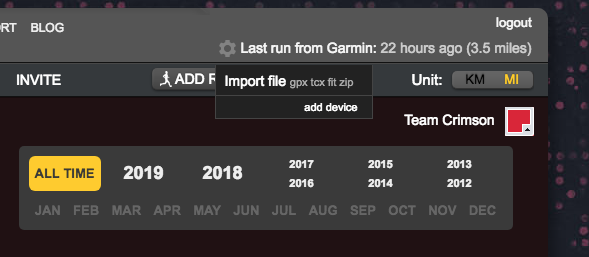
If you'd like to upload an HRM file from polarpersonaltrainer.com, you will need to convert it first using http://polarconverter.com/.
You can also import files via email by sending your GPX/TCX files to your_username@smashrunimport.com. By default, we'll whitelist the email address you're using to login to Smashrun. However, you can whitelist any email address from your settings > profile > scroll to the bottom and expand Import via email.
Note that ZIP files cannot be imported via email.
-
Wie füge ich meine Läufe manuell hinzu?
You can click the ‘Add Run’ icon from any of the dashboards within Smashrun. It’s located on the top-right, next to the scale button.
In order to book a manual run entry, you have to include a start time, distance, and duration. If you’re training by time and need to estimate your distance, try using the GMAP-Pedometer to estimate your distance before you go for a run!
-
Wie editiere oder lösche ich einen Lauf?
You can always edit your runs from the ‘List’ page. By default, it displays your latest list of runs so you will need to use the calendar on the top-right in order to navigate to the specific month that has the run you want to edit.
Once you’re in the correct month and year, just mouse-over the far left column (next to your run dates) to see the ‘edit’ button. Just click ‘Update’ when you’re all set.
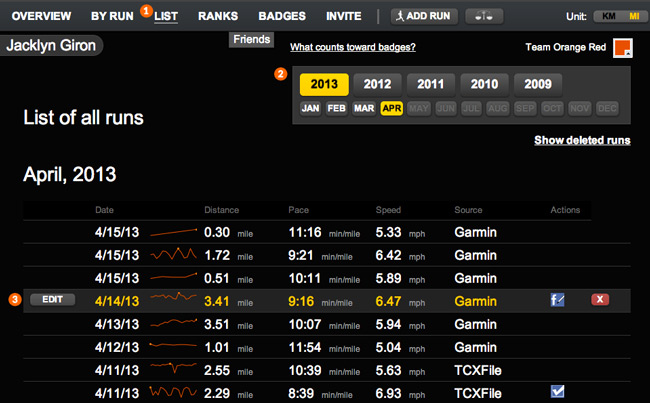
You can also edit a run directly from the By Run page. Just click on the pencil icon inside the toolbox, above the tags and underneath the calendar.
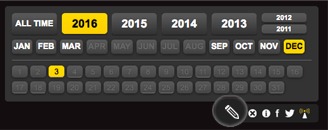
-
Wie finde ich Freunde und folge ihnen?
There’s two ways to find your friends on Smashrun: you can either find/ follow them from the Facebook ‘settings’ page within Smashrun OR you can click on the ‘Friends’ tab on the Overview page, just beneath the link for Ranks and Badges, and click on ‘Search for runners on Smashrun’.
Following a friend will allow you to see their weekly aggregate mileage from your friends drop-down and quickly navigate to their dashboards.
Friends appear in the order of most recent run. The intensity of the color bar indicates how many more or fewer miles/kilometers they ran than you did so far this week.
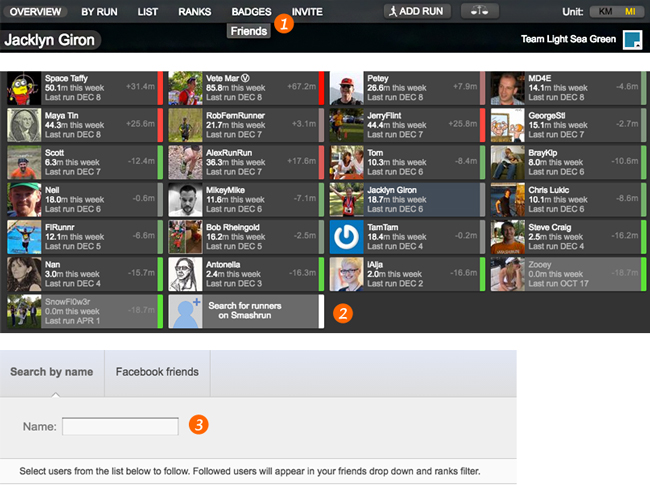
Falls du jemanden "entfolgen" willst, musst du sein Profil besuchen, die Maus über seinen Namen (gelb und in der Nähe zum Übersichtslink( halten und den "Entfolgen" Knopf drücken. Das wird die Person aus deiner Freundesliste entfernen.
-
Wie betrachte ich mehre Rennen am selben Tag?
Falls du mehr als einmal pro Tag läufst, kannst du die Einzelheiten jedes Lauf auf zwei Wege anzeigen:
(1) du kannst auf den spezifischen Lauf auf deiner Auflistungsseite klicken
(2) oder du navigierst zwischen den Läufen des selben Tages unter der By Run Seite. Du wirst unterhalb des Kalenders oben rechts eine Sektion dafür vorfinden. Dies wird nur aufgezeigt, wenn du mehr als einen Lauf pro Tag gelaufen bist.
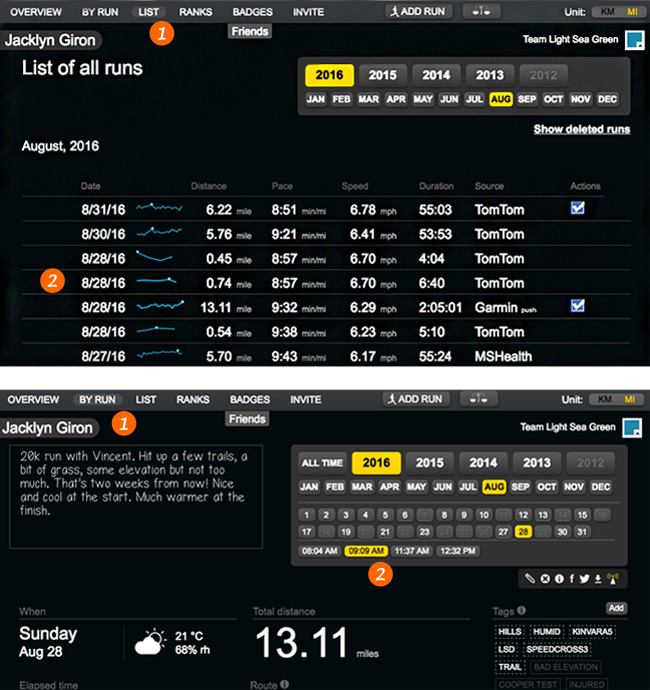
-
Wie berechnet Smash den totalen Kalorienverbrauch?
Smashrun benutzt für den totalen Kalorienverbrauch eine Formal vom Verband der Körperlichen Betätigung.
METS zu Kcal/min = multipliziert METS x 3,5 x Gewicht in kg und dann geteilt durch 200
https://sites.google.com/site/compendiumofphysicalactivities/help/unit-conversionsUm das zu machen, schätzen wir deinen groben Sauerstoffverbrauch (VO2) in jeder Sekunde, die du gerannt bist, basierend auf deiner Geschwindigkeit und der Qualität deines Laufes mit der folgenden Formel von der Amerikanischen Hochschule der Sportmedizin.
VO2 (mL . kg-1 . min-1) = (0.2 . S) + (0.9 . S . G) + 3.5 mL. kg-1.min-1
http://certification.acsm.org/metabolic-calcsDann konvertieren wir VO2 zu METs (dividiere VO2 durch 3,5 ml/min/kg). Daraus resultierend, berechnen wir deine totalen Kalorienverbrauch von Grund auf. Natürlich hat das ganze keinen Sinn, wenn du dein wahres Gewicht vertuschst, da VO2 über ml/kg des Körpergewichts gemessen wird.
-
Was ist die Trainingsleistung?
Die Traillaufleistung sind deine totalen Meilen oder Kilometer auf fortlaufender Basis. Beispielsweise zeigt dir der letzte Punkt auf deiner Trail 7-Tage-Chart die die totalen Meilen oder Kilometer für den einzelnen Tag plus die der vergangenen 6 Tage an.
For more details, check out the release notes for trailing mileage charts: "Trailing miles and weekly running reports"
-
Wie werden PRs berechnet?
Smashrun takes the fastest run you've ever had within 1km or 1mi of one of the benchmark distances that we track, and then interpolates the PR to the benchmark distance. The thought is that a PR is a run for a set distance there and back.
Wenn du 2 km läufst und der erste Kilometer entlang eines Hügels nach oben und der zweite nach unten führt, dann wird dir Kilometer nach unten nicht als PR gezählt. Natürlich kannst du das System so leicht täuschen, in dem du nur den Abfahrslaufanteil nimmst oder im nach genau 1 km eines flaches Laufs hälst.
Gegenwärtig beinhalten die PR Distanzen: 1mi, 3km, 5km, 4mi, 5mi, 10km, 15km, 10mi, 20km, 13.1mi, 40km, 26.2mi, 50km, 100km. Wenn deine Ansicht auf Kilometer eingestellt ist, siehst du die geläufigsten Laufdistanzen in Europa. Wenn deine Ansicht auf Meilen eingestellt ist, siehst du die geläufigsten Laufdistanzen in den U.S.
If you're a Smashrun Pro user, you'll also see your best segments within any given run when you view the Pro Map. So, for example, if you ran a 10k, you'll see the fastest 250m, 400m, 1k, 1mi, 2mi, 5k, etc. within that run. -
Wie werden die Wetterdaten für jeden Lauf bestimmt?
Smashrun looks at the midpoint of the run, searches for the nearest hourly time to the midpoint, and uses the weather values nearest to that. Data accuracy is dependent on the service provider, but you can view their respective sources on DarkSky.net.
-
How do you calculate elevation gain?
There is no standard calculation for elevation gain. The reason is that you may be running on relatively flat ground, but every recording may be up or down a foot or two. If you perform the calculation by adding every increase you'll end up with a really large number, so the trick is disregarding some amount of data, but no more than is necessary.
Most running sites (aside from TrainingPeaks) uses an averaging factor to smooth the data first, combined with a cut-off to disregard any data below a threshold. The results are actually rather inaccurate. So, instead of trying to match numbers that weren't very good in the first place, we decided to focus on getting it as close to "right" as possible.
The method we've adopted is similar to TrainingPeaks, which uses a line simplification algorithm with a resolution of about 10 meters. From that, we calculate the elevation gained. In theory, this should be much more accurate than the smoothing, because smoothing shaves off the peaks of hills.
-
What counts towards badges?
Only runs logged from the date you register and onwards count towards badges. If you're a Pro user, you can choose to earn Pro badges from the date you unlocked them or from the date that you registered. Additionally, for a run to count towards any badge, it has to be at least 1/10th of a mile or 1/10th of a kilometer long.
-
Wie teile ich meine Läufe auf Facebook?
You can manually share a run on Facebook by clicking on the share icon within the By Run page. In addition, as long as it's not your first run and it's not a manual entry, you'll also be prompted after adding a run whether or not you'd like to post it on Facebook. You can turn off the prompt by clicking on 'Don't show again' and choosing 'Never ask to share runs' or only show the prompt if it's a new run or a great run.
Choose the image you'd like to share and highlight a metric you care most about. Any data that's not available for that particular run will be grayed out from your list of 'important stat' options. Click the Facebook button to generate the image and, when it's ready, you can add a comment to your Facebook post before sharing.
You can learn more about your sharing options by reading our blog post on 3 new ways to share your runs.
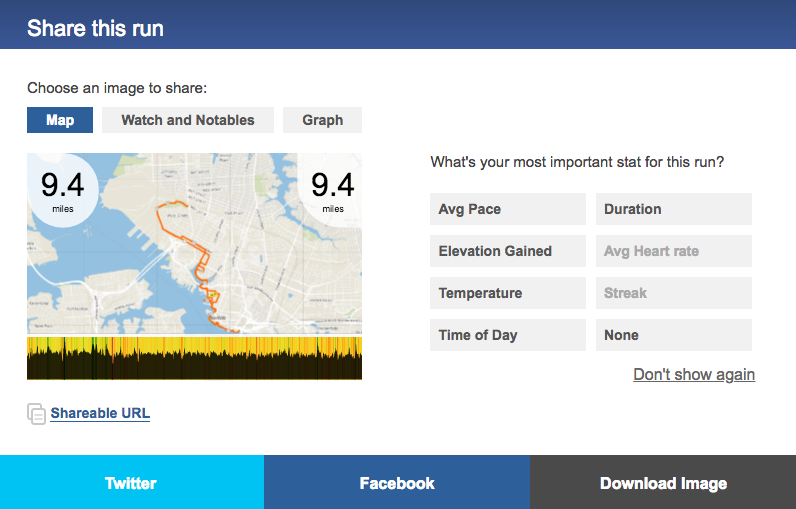
-
Wie lade ich meine Freunde zu Smashrun ein?
Every user has a unique invite page that's already been set up. To view your invite options, click on ‘INVITE', which is the last link on the sub-heading. You can either send an email, share the link to your invite page, or post your invite to Facebook. Too easy! And you can earn badges for it!
-
What if I made a mistake during registration and ended up with multiple Smashrun accounts?
Log in to the duplicate account > go to settings > account > and deactivate the dupe. If you can't log in for some reason, email us.